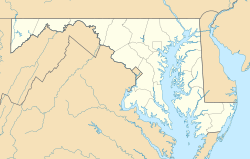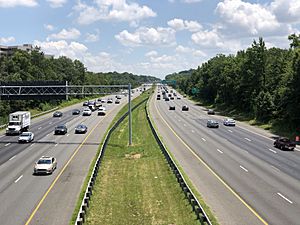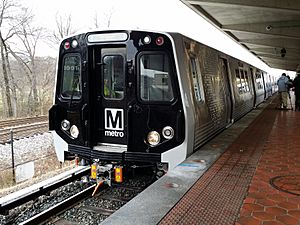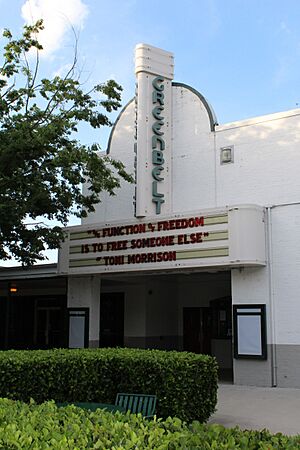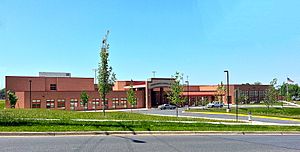Greenbelt, Maryland facts for kids
Quick facts for kids
Greenbelt
|
|||
|---|---|---|---|
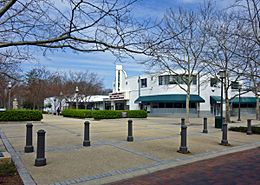
Roosevelt Center in March 2011. The city's commercial center typifies the Art Deco style used during the original construction of Greenbelt.
|
|||
|
|||
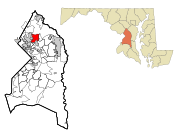
Location in Prince George's County and Maryland
|
|||
| Country | United States | ||
| State | Maryland | ||
| County | Prince George's | ||
| Incorporated | June 1, 1937 | ||
| Area | |||
| • Total | 6.29 sq mi (16.29 km2) | ||
| • Land | 6.24 sq mi (16.15 km2) | ||
| • Water | 0.06 sq mi (0.14 km2) 0.99% | ||
| Elevation | 157 ft (48 m) | ||
| Population
(2020)
|
|||
| • Total | 24,921 | ||
| • Density | 3,996.95/sq mi (1,543.35/km2) | ||
| Time zone | UTC−05:00 (Eastern) | ||
| • Summer (DST) | UTC−04:00 (Eastern) | ||
| ZIP Codes |
20768, 20770–20771
|
||
| Area codes | 301 & 240 | ||
| FIPS code | 24-34775 | ||
| GNIS feature ID | 2390596 | ||
Greenbelt is a city in Prince George's County, Maryland, United States. It is a suburb of Washington, D.C.. In 2020, about 24,921 people lived there.
Greenbelt is famous for being the first and largest of the three "Greenbelt Towns." These towns were special projects started by the federal government during the New Deal era. The idea was to create planned communities. The other two towns are Greenhills, Ohio, and Greendale, Wisconsin.
The project began in 1935, led by Rexford Tugwell, who worked for the United States Department of Agriculture. President Franklin D. Roosevelt officially started the Resettlement Administration to build these towns. Construction in Greenbelt began on January 13, 1936. The first residents moved in on September 30, 1937. The buildings were designed in cool styles like Art Deco and Streamline Moderne.
Greenbelt is seen as a big step in how cities are planned. It inspired other planned communities near Washington, D.C., like Reston, Virginia, and Columbia, Maryland. The oldest part of the city, called Old Greenbelt, is a National Historic Landmark District. This means it's a very important historical place.
Contents
- Discovering Greenbelt: Location and Features
- Getting Around Greenbelt: Transportation Options
- Neighboring Communities of Greenbelt
- Greenbelt's Story: A Planned Community's History
- Greenbelt's People: Demographics
- Greenbelt Historic District: A Look Back in Time
- Learning in Greenbelt: Schools and Libraries
- Notable People from Greenbelt
- Greenbelt's Economy: Jobs and Growth
- Images for kids
- See also
Discovering Greenbelt: Location and Features
Greenbelt is located at Lua error in Module:Coordinates at line 614: attempt to index field 'wikibase' (a nil value).. The city covers about 6.24 square miles of land and a small amount of water. Greenbelt has a few different ZIP Codes. The 20770 ZIP Code is for homes and businesses inside the city. The 20768 ZIP Code is for P.O. Box addresses.
NASA's Goddard Space Flight Center
NASA's Goddard Space Flight Center is right next to Greenbelt. It uses a Greenbelt postal address (Greenbelt, MD 20768). This important space center is a big part of the area.
Greenbelt Park: A Natural Escape
Greenbelt Park, which is part of the National Park Service, is also within the city's boundaries. It's a great place for outdoor activities.
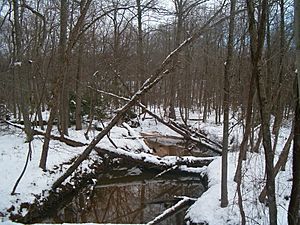
Getting Around Greenbelt: Transportation Options
Greenbelt has important roads and public transportation that connect it to other areas.
Major Roads and Highways
Two big highways run through Greenbelt:
- The Capital Beltway (I-95/I-495) is a major highway that circles Washington, D.C.
- The Baltimore–Washington Parkway (MD 295) is a scenic road that connects Baltimore and Washington, D.C. Part of this parkway in Greenbelt is listed on the National Register of Historic Places.
Other important roads include Greenbelt Road, which links several nearby communities. Kenilworth Avenue (MD 201) also goes through Greenbelt, offering another way to get to Washington, D.C.
Public Transit Services
Greenbelt is well-connected by public transportation:
- Washington Metro: The Greenbelt station is the last stop on Metro's Green Line. This train system helps people travel throughout Washington, D.C., and its nearby areas.
- MARC Train: This commuter train service also stops at Greenbelt station. It connects Washington, D.C., to Baltimore.
- Metrobus: Various bus routes serve Greenbelt, making it easy to get around the city and to other parts of Prince George's County.
- THE BUS: Prince George's County's own bus service has routes in Greenbelt.
- University of Maryland's Shuttle-UM: This shuttle provides transportation for students and, at times, for Greenbelt residents.
- Greenbelt Connection: The city also runs a small van service for local transportation.
Neighboring Communities of Greenbelt
Greenbelt shares its borders with several other areas:
- Beltsville Agricultural Research Center
- Berwyn Heights
- College Park
- Goddard
- Lanham
- New Carrollton
- Glenn Dale
Greenbelt's Story: A Planned Community's History
Greenbelt was founded on September 30, 1937. It was created as a public cooperative community during the New Deal era. The main goal was to build an "ideal" community that would also help with the housing shortage near Washington, D.C. Building the town also created many jobs, which helped the country recover from the Great Depression.
The Vision of the Greenbelt Towns
President Franklin D. Roosevelt's advisor, Rexford Tugwell, came up with the idea for Greenbelt and two other Greenbelt Towns in 1935. These towns were designed to provide affordable housing for federal government workers. The United States Congress passed a law in April 1935 to fund these projects. Then, President Roosevelt created the Resettlement Administration in May 1935, with Rexford Tugwell as its leader.
The other Greenbelt Towns are Greendale, Wisconsin (near Milwaukee) and Greenhills, Ohio (near Cincinnati). A fourth town, Roosevelt, New Jersey, was also planned.
Eleanor Roosevelt's Involvement
Eleanor Roosevelt, President Roosevelt's wife, helped plan the Maryland town. She was very involved in creating cooperative communities. In Greenbelt, this cooperative spirit led to:
- The Greenbelt News Review (a local newspaper)
- The Greenbelt Consumers Coop grocery store
- The New Deal Cafe
- Greenbelt Homes Incorporated (GHI), which manages the original housing.
Community Planning and Evolution
The way Greenbelt was planned was very new and different. People who wanted to live there were interviewed. The community aimed to create a specific type of living environment. Over time, Greenbelt became more diverse. The historic part of the city, planned by the federal government, is now part of the Greenbelt Historic District.
Greenbelt was even featured in a 1939 documentary film called The City.
Greenbelt's People: Demographics
Greenbelt's population has grown over the years.
| Historical population | |||
|---|---|---|---|
| Census | Pop. | %± | |
| 1940 | 2,831 | — | |
| 1950 | 7,074 | 149.9% | |
| 1960 | 7,479 | 5.7% | |
| 1970 | 18,199 | 143.3% | |
| 1980 | 17,332 | −4.8% | |
| 1990 | 21,096 | 21.7% | |
| 2000 | 21,456 | 1.7% | |
| 2010 | 23,068 | 7.5% | |
| 2020 | 24,921 | 8.0% | |
| U.S. Decennial Census 2010 2020 |
|||
Population in 2020
In 2020, Greenbelt had 24,921 people. Here's a look at the different groups living in the city:
| Race / ethnicity (NH = Non-Hispanic) | Pop 2010 | Pop 2020 | % 2010 | % 2020 |
|---|---|---|---|---|
| White alone (NH) | 5,974 | 5,176 | 25.90% | 20.77% |
| Black or African American alone (NH) | 10,852 | 11,897 | 47.04% | 47.74% |
| Native American or Alaska Native alone (NH) | 43 | 47 | 0.19% | 0.19% |
| Asian alone (NH) | 2,238 | 2,323 | 9.70% | 9.32% |
| Pacific Islander alone (NH) | 18 | 10 | 0.08% | 0.04% |
| Other race alone (NH) | 61 | 192 | 0.26% | 0.77% |
| Mixed race or Multiracial (NH) | 581 | 996 | 2.52% | 4.00% |
| Hispanic or Latino (any race) | 3,301 | 4,280 | 14.31% | 17.17% |
| Total | 23,068 | 24,921 | 100.00% | 100.00% |
Population in 2010
In 2010, there were about 23,068 people living in Greenbelt. There were 9,747 households. About 31% of households had children under 18. The average age in the city was 33.7 years. About 22.8% of residents were under 18.
Greenbelt Historic District: A Look Back in Time
The original, planned part of Greenbelt is called the Greenbelt Historic District. It was recognized as a historic place in 1980 and became a National Historic Landmark District in 1997.
Roosevelt Center: The Heart of Old Greenbelt
The district includes Roosevelt Center. This center was originally called The Center. It was later renamed to honor President Roosevelt. Roosevelt Center has:
- The Greenbelt Co-op Supermarket and Pharmacy, which opened in 1984.
- The historic Old Greenbelt Theatre, which opened in 1938.
- The Greenbelt Arts Center, located where a bowling alley used to be.
- The New Deal Cafe, named after the New Deal era when the city was founded.
Both the Co-op and the New Deal Cafe are non-profit cooperative businesses. This means they are owned and run by their members.
Learning in Greenbelt: Schools and Libraries
Greenbelt's schools are part of Prince George's County Public Schools (PGCPS).
Elementary Schools
There are three public elementary schools that serve different parts of Greenbelt:
- Greenbelt Elementary School
- Magnolia Elementary School
- Springhill Lake Elementary School
Middle School
All of Greenbelt is served by Greenbelt Middle School. This school has a special program for talented and gifted students.
High School
Students from Greenbelt attend Eleanor Roosevelt High School. This high school offers a Science and Technology magnet program.
Specialty School
There is also a public magnet school called Dora Kennedy French Immersion School. It teaches students from kindergarten to 8th grade using the French language.
Public Libraries
Greenbelt has its own library branch, the Greenbelt Branch of the Prince George's County Memorial Library System.
Notable People from Greenbelt
Many interesting people have lived in Greenbelt, including:
- Isaiah Prince, an offensive lineman for the Cincinnati Bengals.
- Phyllis Richman, a restaurant critic for The Washington Post.
- Rosa Salazar, an actor.
- Joe Pug, a musician.
Greenbelt's Economy: Jobs and Growth
Greenbelt has a strong economy with many different employers.
Top Employers in Greenbelt
Here are some of the top employers in the city:
| Number | Employer | Employees |
|---|---|---|
| 1 | City of Greenbelt | 463 |
| 2 | Bozzuto Group | 460 |
| 3 | Eleanor Roosevelt High School | 350 |
| 4 | Burlington Stores, Inc. | 229 |
| 5 | Springhill Lake Hotel Partners, LLC | 148 |
| 6 | Paradyme Management Inc. | 134 |
| 7 | Martin's | 130 |
| 8 | Giant Food of Maryland, LLC | 126 |
| 9 | Greenbelt Middle School | 123 |
| 10 | ATA Aerospace, LLC | 116 |
Note: This list does not include the US Federal Government, which is a very large employer in the area, including NASA's Goddard Space Flight Center.
Future Growth: The FBI Headquarters
In late 2023, it was announced that the FBI will be moving its main offices to Greenbelt. This is a huge project that will bring 7,500 staff members to the city. This new complex will be built near the Metro station, and more development is planned around it.
Images for kids
-
Lenore Thomas Straus panel, Community Center
-
Art Deco apartments
See also
 In Spanish: Greenbelt (Maryland) para niños
In Spanish: Greenbelt (Maryland) para niños




